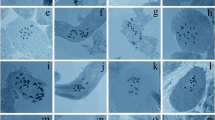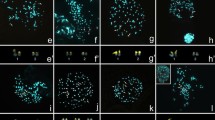Abstract
Chromosome numbers for 26 different species of the generaPiper, Peperomia andPothomorphe (Piperaceae) are reported. The basic chromosome numbers are 2n = 26, x = 13 (Piper, Pothomorphe) and 2n = 22, x = 11 (Peperomia), polyploid series are characteristic forPiper andPeperomia. Piper has the smallest chromosomes and prochromosomal interphase nuclei,Peperomia the largest ones and mostly reticulate to euchromatic nuclei.Pothomorphe is intermediate in both characters. The karyomorphological differences betweenPothomorphe andPiper underline their generic separation. Interspecific size variation of chromosomes occurs inPiper andPeperomia. Infraspecific polyploidy was observed inPiper betle. C-banding reveals different patterns of heterochromatin (hc) distribution between the genera investigated. The genome evolution is discussed.
Similar content being viewed by others
References
Abele, K., 1924: Untersuchungen an Gametophyten vonPeperomia incana. — Bot. Archiv7: 321–324.
Albert, C., Smith, F. L. S., 1975: The genusMacropiper (Piperaceae). — Bot. J. Linn. Soc.71: 1–38.
Blot, J., 1960: Contribution à l'étude cytologique du genrePeperomia. — Rev. Gén. Bot.67: 522–535.
Brücher, H., 1977: Tropische Nutzpflanzen. — Berlin, Heidelberg, New York: Springer.
Burger, W. C., 1971: The problems withPiper. — Amer. J. Bot.58: 462.
Darlington, C. D., Janakiammal, E. K., 1945: Chromosome atlas of flowering plants. — London: George Allen & Unwin.
Dasgupta A., Datta, P. C., 1976: Cytotaxonomy ofPiperaceae. — Cytologia41: 697–706.
Ehrendorfer, F., Schweizer, D., Greger, H., Humphries, C., 1977: Chromosome banding and synthetic systematics inAnacyclus (Asteraceae - Anthemideae). — Taxon26: 387–394.
Gamble J. S., 1925: Flora of Presidency of Madras7: 1202–1210.
Guerra, M., 1983: O uso de Giemsa na citogenética vegetal — comparação entre a coloração simples e o bandeamento. — Ciência e Cultura35: 190–193.
Hauser, R., 1916: Beitr. allg. Bot.1: 115. — InDarlington, C. D., Wylie, A. P., 1955, (Eds.): Chromosome atlas of flowering plants. — London: George Allen & Unwin.
Howard, R. A., 1973: Notes on thePiperaceae of the Lesser Antilles. — J. Arn. Arb.54: 377–411.
Huber, H., 1987:Piperaceae. — InDassanayake, M. D., Fosberg, F. R., (Eds.): A revised handbook to the Flora of Ceylon. Vol. 6. — New Delhi: Amerind Publishing Co.
Jose, J., Sharma, A., 1985: Structure and behaviour of chromosomes inPiper andPeperomia (familyPiperaceae). — Cytologia50: 301–310.
Martin, F. W., Gregory, L. E., 1962: Mode of pollination and factors affecting fruit set inP. nigrum L. in Puerto Rico. — Crop Sci.2: 295–299.
Mathew, P. M., 1958: Studies onPiperaceae. — J. Indian Bot. Soc.37: 155–171.
—, 1973: Karyomorphological studies inPiper nigrum L. — J. Plant. Crops, Suppl.1: 15–18.
Morawetz, W., 1981: Karyologie und ökologisch-morphologische Differenzierung vonPeumus boldus (Monimiaceae, Laurales). — Pl. Syst. Evol.138: 157–173.
—, 1985: Beiträge zur Karyologie und Systematik der GattungThottea (Aristolochiaceae). — Bot. Jahrb. Syst.107: 329–342.
—, 1986a: Remarks on karyological differentiation patterns in tropical woody plants. — Pl. Syst. Evol.152: 49–100.
—, 1986b: Systematics and karyoevolution inMagnoliidae:Tetrameranthus as compared with otherAnnonaceae genera of the same chromosome number. — Pl. Syst. Evol.154: 147–173.
—, 1988: Karyosystematics and evolution of AustralianAnnonaceae as compared withEupomatiaceae, Himantandraceae, andAustrobaileyaceae. — Pl. Syst. Evol.159: 49–79.
Okada, H., 1975: Karyomorphological studies in woodyPolycarpicae. — J. Sci. Hiroshima Univ. Ser. B., Div. 2, Bot.15: 115–200.
—, 1986: Karyomorphology and relationships in some genera ofSaururaceae andPiperaceae. — Bot. Mag. Tokyo99: 289–299.
Sampathkumar, R., 1981: InLöve, A., (Ed.): Chromosome number reports 72. — Taxon30: 696.
Samuel, M. R. A., Bavappa, K. V. A., 1981: Chromosome numbers in the genusPiper. — Curr. Sci.50: 197–198.
Schwarzacher, T., Ambros, P., Schweizer, D., 1980: Application of Giemsa C-banding to orchid karyotype analysis. — Pl. Syst. Evol.134: 293–297.
Sharma, A. K., Bhattacharyya, N. K., 1959: Chromosome studies on two genera of the familyPiperaceae. — Genetica29: 256–289.
Smith, J. B., 1966: Chromosome numbers inPeperomia Ruiz. & Pav. (Piperaceae) and a note on chromosome number ofPiper magnificum Trelease. — Kew Bull.20: 521–526.
Vijistella Bai, G., Subramanian, D., 1985: Cytotaxonomical studies of South IndiaPiperaceae. — Cytologia50: 583–592.
Author information
Authors and Affiliations
Rights and permissions
About this article
Cite this article
Samuel, R., Morawetz, W. Chromosomal evolution withinPiperaceae . Pl Syst Evol 166, 105–117 (1989). https://doi.org/10.1007/BF00937879
Received:
Accepted:
Issue Date:
DOI: https://doi.org/10.1007/BF00937879




